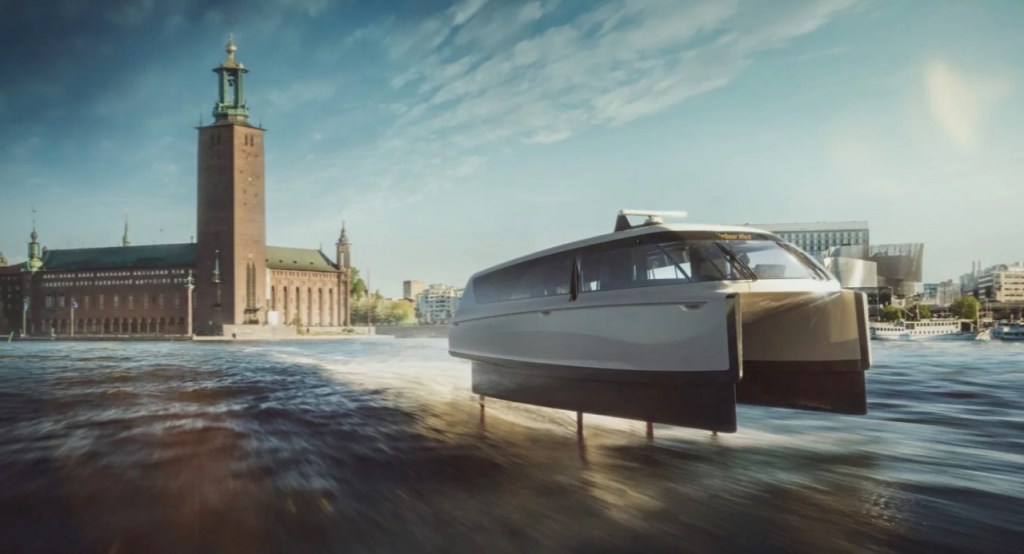Swedish company Candela this summer will launch its 30-passenger commercial hydrofoil shuttle, the P-12, the vessel it believes will change the course of motorized water transport. Following its C-7 and C-8 leisure cruisers, Candela has already been making waves with its drive to transition to fossil-free waterways.
“We are now heavy into the process of finalizing the development and putting this ferry into production, which we think is going to be kind of a game changer in public transportation,” said Gustav Hasselskog, Candela’s founder and CEO.
The company raised SEK 210 million (around $20 million) in a round co-led by EQT Ventures and investor duo Joel Eklund (Fosielund Holding AB) and Svante Nilo Bengtsson (Marknadspotential AB), with participation from Ocean Zero LLC and others. This follows its $24 million round from last year.
The P-12 is an electric-powered hydrofoil that effectively flies over the surface of the water on computer-guided underwater wings. It has a range of up to 60 nautical miles at a cruising speed of 27 knots. Being electrically powered makes the P-12 cleaner and greener than traditional diesel-fueled craft, which also makes it cheaper to operate. Candela estimates that the P-12 uses 80% less energy than a traditional vessel.
“It’s a very good thing for the environment. In total, the shipping industry is around 3% of total carbon emissions,” says Hasselskog. However, as well as the benefits of being electric-powered, the P-12 is designed to be low maintenance and with lower service costs.
“We use a low maintenance type of dry drain. We have developed this pod motor, which doesn’t have any gears, any oil or anything; it’s just motors underneath the water,” explains Hasselskog.
If the decision to make a passenger vessel with a maximum capacity of 30 people seems a little unusual, it’s because it is designed for coastal, archipelago or lake-based transport, and how people actually use water transport in these geographies.
“It looks the same in Oslo, in Stockholm, in New York and everywhere: most of these boats are typically 300 passengers. But when you study optimal boat size, especially in Stockholm, Istanbul and in San Francisco, it’s concluded that it’s not the optimal boat size. Seat utilization is typically super low. In Stockholm, it’s 5% over the year,” says Hasselskog. “When you have only 30 passengers, you don’t need more than one staff member on board; otherwise, you need three staff members. If you put that all together, you get a very good cost equation, and that’s why we went with this format. Operators save typically around 40% compared to traditional, large, diesel setups.”
Smaller craft can also be deployed more flexibly, for example, by operating on an on-demand basis rather than on a fixed timetable, and can travel to more remote locations. The company says this format has huge cost-efficiency benefits for operators.
Candela is looking to build on this flexible approach to transport and is currently developing its own software to enable real-time fleet routing.
“The first one we’re going to put in water is for the city of Stockholm,” says Hasselskog. “It’s going to run from a suburb outside of town into the center. If you travel that route today by bus and subway, or by the current boat, it takes 50 minutes. We can do that in 25 minutes, the reason being we don’t create any wake so we have permission to go faster. If we can save commuters’ journey time, that makes a huge difference.”
Navier’s 30-foot hydrofoiling electric boat hits the water and prepares for production
For Candela and Hasselskog, the future looks like large fleets of small craft that can travel more quickly to more remote locations with greater flexibility. It might be starting in Stockholm, but it estimates that the market is €15 billion in size, and the format has global appeal.
”The next step for us here is to… take a place like Stockholm, where there are, say, 35 big ferries today. We will replace them with 120 of ours,” says Hasselskog. And from there: “It’s a global business that we envision and so far, we are in dialogue with hundreds of customers. They are spread from Hong Kong to Sydney. There are a lot in the Gulf region, in Europe, and we have dialogues in Mexico, Belize, San Francisco, New York.”
The company is taking a big bet that bigger isn’t always better, in the hope that smaller can mean faster, greener and more serviceable.































Comment